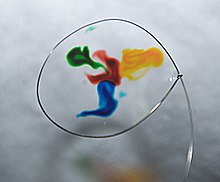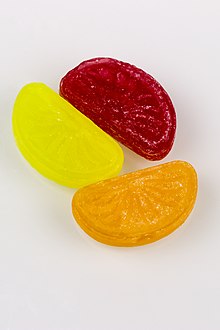Food coloring
Food colors are food additives that compensate for processing-related changes in color or are intended to satisfy consumers' color expectations .
Food can be colored with different groups of colorants:
- Natural dyes obtained from plants or animals. Examples: carotenoids , berry coloring agents ( anthocyanins ), beet coloring agents ( betanin ) and coloring agents from spices such as paprika , saffron and turmeric ( curcumin ). Synthetically produced dyes with the same chemical structure as naturally occurring dyes are called nature-identical.
- Synthetic organic dyes that do not occur naturally. These are essentially various azo dyes such as tartrazine (E102), yellow orange S (E110), azorubine (E122), cochineal red A (E124) and allura red AC (E129), but also non-azo dyes, e.g. B. Quinoline Yellow (E104), Blue Indigotine (E132), and Green S (E142)
The coloring of food is also possible with
- inorganic pigments, such as. B. Titanium dioxide (E171), silver (E174) and gold (E175).
- strongly coloring plant and fruit extracts, such as. B. beetroot , spinach or elderberry juice , which are not considered to be colorants in the legal sense and are not labeled with an E number as a food additive.
use
The following reasons speak in favor of coloring food with dyes:
- Compensation for processing-related color losses, e.g. B. in the preservation of fruits
- Color correction for products that, due to their ingredients, have a weaker color than the consumer expects. (e.g. with drinks or sauces)
- Achieving a constant, standardized color in products made from raw materials with varying quality and color strength.
- Increasing the attractiveness of products that are colorless or unsightly (e.g. margarine, sweets, desserts)
- Making the typical food taste recognizable (e.g. red candies with cherry flavor, yellow candies with lemon flavor)
The use of food coloring to make an inferior product appear better in quality is not legally permitted (prohibition of deception).
Food dyes are also used in applications where the health or toxicological safety is important, e.g. B .:
- Paints for children are often made from food coloring and are therefore harmless to health if they get into the mouth and digestive system.
- When tracing underground water courses by coloring and tracking the colored water.
- The color cartridges for paintball are filled with food coloring for safety reasons.
- Use of food coloring in cosmetics .
history
Coloring food was common practice in many cultures for millennia. Until the 19th century, only natural dyes or mineral pigments obtained from plants or animals were available. Saffron was used to color food as early as ancient Egypt . Other important dyes were koschenille - in use in South and Central America for centuries, available in Europe from the 16th century - and indigo , for example obtained from woad . After 1850, many synthetic dyes were developed that were mainly used in textile dyeing, but were also used to color food. Compared to the natural dyes, synthetic dyes showed better stability and a higher color intensity . In addition, the development of the chemical industry in the second half of the 19th century made them accessible on a large scale and comparatively inexpensively.
Initially, the coloring of food was not regulated by law. The toxicity of some dyes, especially representatives from the group of azo dyes, was not yet known or went unnoticed. Thus cheese with mercuric sulfide and confectionery with lead oxide colored. Colorants were sometimes used with fraudulent intent, for example red wine was colored with fuchsine , pastries were made yellow to simulate a higher egg content, oranges were turned into "blood oranges" by injecting them with a red dye solution or the color of old meat was "improved". The United Kingdom pioneered the legal regulations with the "Sale of Food and Drugs Act" of 1875. From 1887, the first food law in the German Reich banned the use of food additives containing heavy metals. This law did not apply to synthetic colors and there were not yet any maximum permitted levels of additives in food. In the USA , the coloring of food was first regulated by law in 1906 in the "Federal Food and Drug Act". From 1907 onwards, the 80 synthetic food colors used in the USA were systematically examined and toxicologically assessed by the German chemist Bernhard Hesse. Many synthetic colors have been banned from use as food colors as a result of this work. In Europe, a 1962 directive for the EEC member states was the first to uniformly regulate which dyes may be used in foods, which purity requirements they must then meet and how they are to be called and with what number they are to be labeled . For standardization, in the absence of other classification systems, reference was made to common names at the time, chemical names or descriptions of origin or manufacture as well as the dye tables by Gustav Schultz from 1931, the Rowe Color Index from Frederick Maurice Rowe (1891–1947) from 1924 and a compilation the dye commission of the DFG from 1957. You started with 1, sorted according to field of application and according to color and started with in the mass or on the surface yellow color (second digit = 0). The system of E numbers developed from these three-digit, initially so-called EEC numbers.
Legal regulations and labeling
Codex Alimentarius
The Codex Alimentarius Commission, founded by the UN in 1963, develops standards and norms for food safety and product quality.
European Union
The use of food coloring was originally regulated by EU Directive 94/36 / EC of June 30, 1994. This was superseded by the EC Regulation No. 1333/2008 of December 16, 2008 on food additives.
Only approved food additives with an E number may be placed on the market. These additives must be identified on the product. Certain foods may not be provided with color additives. These are especially untreated foods and staple foods such as milk, sugar, fruits, vegetables and mushrooms. For some foods, only certain colorings with fixed maximum quantities are permitted (example: breakfast cereal products flavored with fruit may only contain the colorings E 120, E 162 and E 163 with a maximum of 200 mg / kg).
Food that contains the following colorings must also be labeled with the words "May impair activity and attention in children":
- E 102 - tartrazine
- E 104 - quinoline yellow
- E 110 - yellow orange p
- E 122 - Azorubine
- E 124 - Cochineal Red A
- E 129 - Allura red AC
There is no labeling requirement if, in the case of composite foods, the coloring agent reaches the end product via an individual component and no longer has a technological effect in it.
Germany
The European guidelines have been implemented in national law with the Food and Feed Code (LFGB).
List of approved food colors
| material | number | coloring | comment |
|---|---|---|---|
| Allura red AC | E 129 | red | |
| aluminum | E 173 | silvery gray | inorganic pigment |
| Amaranth | E 123 | red | |
| Anthocyanins | E 163 | red, purple, blue | |
| Azorubine | E 122 | red | |
| Betanin | E 162 | red | |
| Braun HT | E 155 | red-brown | |
| Brilliant blue FCF | E 133 | blue | |
| Brilliant black BN | E 151 | purple, brown, black | |
| Calcium carbonate | E 170 | White | inorganic pigment |
| Canthaxanthin | E 161 g | red | |
|
Carotene * Annatto ( Bixin , Norbixin ) * Paprika Extract ( Capsanthin , Capsorubin ) * Lycopene * Beta-apo-8′-Carotinal |
E 160 a E 160 b E 160 c E 160 d E 160 e |
yellow, orange | |
| Quinoline yellow | E 104 | yellow | |
| Chlorophyll | E 140 | green | |
| Cochineal red A | E 124 | red | |
| Curcumin | E 100 | orange yellow | |
| Iron oxides and iron hydroxides | E 172 | yellow, red, brown, black | inorganic pigment |
| Erythrosine | E 127 | pink | |
| Yellow orange S | E 110 | yellow-orange | |
| gold | E 175 | golden yellow | inorganic pigment |
| Green S | E 142 | green | |
| Indigo carmine | E 132 | blue | |
| cochineal | E 120 | red | |
| Copper-containing complexes of chlorophylls and chlorophyllines | E 141 | green | |
| Lithol Ruby BK | E 180 | red | |
| Lutein | E 161 b | golden yellow, orange yellow | |
| Patent blue V | E 131 | blue | |
| Biochar | E 153 | black | pigment |
|
Riboflavin (lactoflavin, vitamin B2) * Riboflavin-5-phosphate |
E 101 E 101 a |
yellow | |
| silver | E 174 | silver gray | inorganic pigment |
| Tartrazine | E 102 | lemon yellow | |
| Titanium dioxide | E 171 | White | inorganic pigment |
|
Caramel * Caustic sulphite caramel * Ammonia caramel * Sulphite ammonia caramel |
E 150 a E 150 b E 150 c E 150 d |
black |
Note: For the sake of completeness, the table lists not only the actual food coloring but also pigments approved as food additives.
literature
- Gisbert Otterstätter: Coloring of foods, medicines, cosmetics. 3. Edition. Behr's Verlag, Hamburg 2007, ISBN 978-3-89947-369-8
- Klaus Hunger (Ed.): Industrial Dyes, Chemistry, Properties, Applications. WILEY-VCH Verlag, Weinheim 2003, ISBN 3-527-30426-6
- Heinrich Zollinger: Color Chemistry. 3. Edition. WILEY-VCH Verlag, Weinheim 2003, ISBN 3-906390-23-3
- R. Hütter: Colorful and seductive . Orelli Füssli publishing house, Zurich 1991, ISBN 3-280-02073-5 .
- Catalysis environmental group, what we all swallow. Rowohlt Verlag, Reinbek 1985, ISBN 3-498-03442-1 , pp. 14-17, pp. 28-33.
- H. Kläui, O. Isler: Why and with what do you color food? . In: Chemistry in our time , 1981, No. 15, pp. 1-9, doi : 10.1002 / ciuz.19810150103 .
Web links
- Zusatzstoffe-online.de , forum for information and advice on additives
- Alison Downham, Paul Collins: Coloring our foods in the last and next millennium. In: International Journal of Food Science and Technology. 35, 2000, pp. 5-22.
Individual evidence
- ↑ Ai Hisano: The Rise of Synthetic Colors in the American Food Industry, 1870-1940. In: Business History Review. Volume 90, Special Issue 3 (A Special Issue on Food and Agriculture), Autumn 2016, pp. 483-504.
- ^ Sale of Food and Drugs Act , accessed October 16, 2018.
- ↑ Federal Food and Drugs Act of 1906 (The "Wiley Act") (PDF), accessed October 16, 2018.
- ↑ Directive of the Council for the approximation of the laws of the member states for coloring substances that may be used in food of October 23, 1962, Appendix I with the EEC numbers
- ↑ Regulation EU Directive 94/36 / EC on colorings that may be used in food (PDF) , accessed on October 16, 2018.
- ↑ Regulation (EC) No. 1333/2008 of December 16, 2008 on food additives
- ↑ Authorization and use of food additives on the website of the Federal Ministry of Food and Agriculture , accessed on October 16, 2018.
- ↑ Food and Feed Code - LFGB (PDF), accessed on October 16, 2018.



